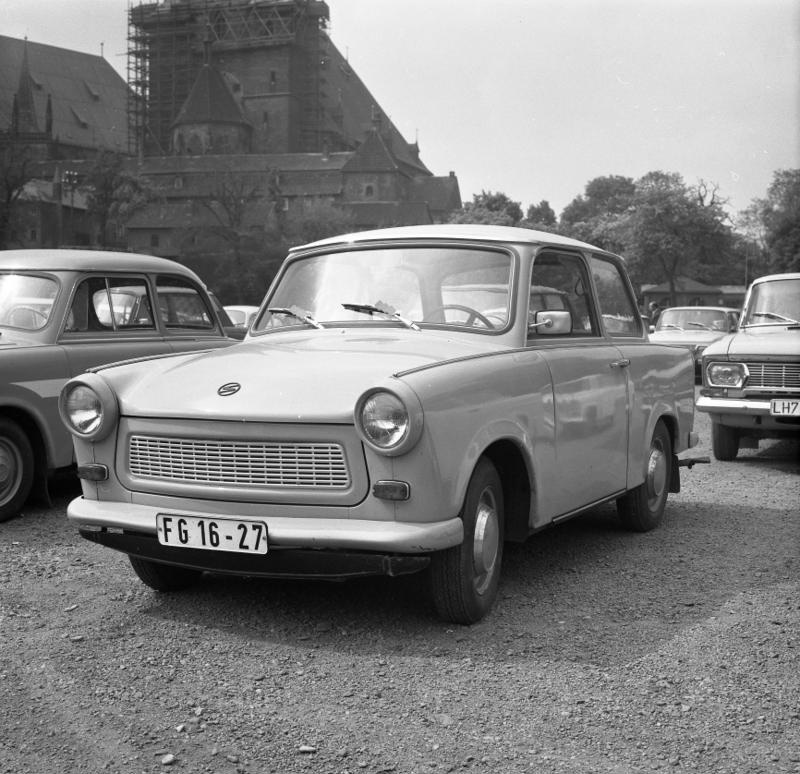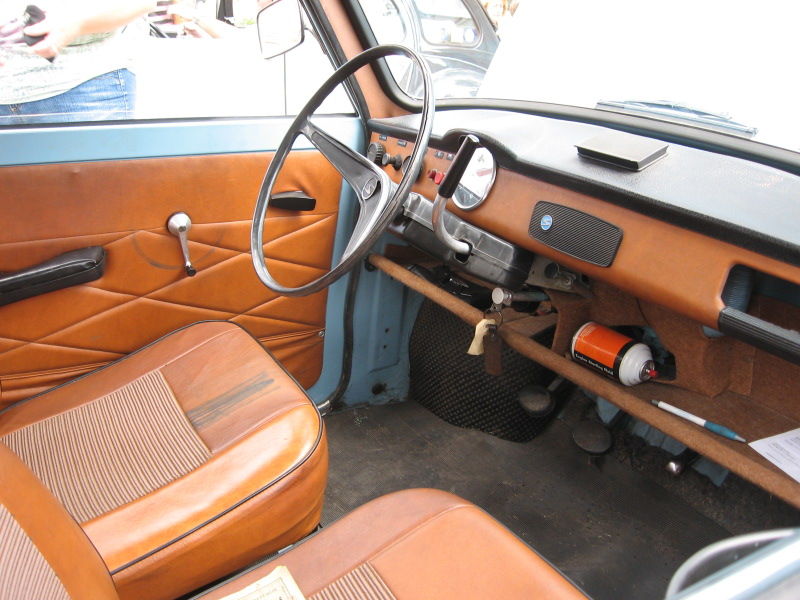While living behind the iron curtain we had one and were glad to have a car at all. The price of this minicar was 40.000 KČS (Czechoslovak crowns). To bring this number in real context, if an average person at that time spared 1/5 of the monthly income (300 KČS of 1.500) for the car, than there was a need of 133 months to spare the money.
Eleven years (+- 20%), for this :
Not really funny, isn't it ? Btw. a Saab, at that time available only in selected shops, costed 4-6x more.
But that's another story.
On the pictures is Trabant 1.1, we had it's predecessor Trabant 601, which looked very similar and had a weaker engine.
The Trabant 601, produced 1963 - 1990, had a 600 ccm two cylinder two-stroke engine with performance of overwhelming 27 hp and 51Nm at 3.000 rpm. It took 30 seconds to bring him to 100kmh which was also the top speed. You can read the full specs here.
The fuel for this was called Special MIX, which was a mixture of petrol and oil in 50:1 ratio. This was once a normal petrol to get on a gas station. Made special for the two stroke cars from the German Democratic Republic (Trabant and Wartburg).
The fuel consumption was 9 L/100 km (26 mpg) in the city and 7 L/100km (34 mpg) on the highway. This is todays consumption of petrol cars with ~2 liter engines doing the 0-100kmh three times faster.
Trabant didn't had an indicator for fuel level. So if your tank was empty, you had a special manual knob, located under the hood or inside, which you had to turn and got a "reserve" for about 50 km, means to the next gas station.
On the dashboard, there were no LED diods or similar indicators at all. Everything pure analogue.
There are some interior pictures on the internet, the closest one to what I remember is this :
Minimalism pure :) Please notice the shifting knob on the dashboard. It had 4 speeds, manual shifting, sometimes very tough. "Pull and up" was 1st gear, "pull and down" was the 2nd gear, "push and up" was 3rd and "push and down" was fourth.
Also there is another thing missing on the dashboard - the ventilation shafts. Which means no circulating air inside. Therefore there were some Trabants had an "personal upgrade" done by a 12V blower sticked to the windshield. The electricity had to be taken by cable somewhere from the dashboard. Home garage work.
The body of the car was made from bakelite. You don't know what is it ? It's polyoxybenzylmethylenglycolanhydride. Sounds familiar, doesn't it ? :) Well it's a kind of plastic, the same plastic from billiard balls or dominoes are made. One of the main ingredients is wool. Yes wool. In 1990. Imagine to drive a car with body from a mixture of billiard balls and wool. Doesn't sounds too safe. Indeed by todays car safety standards Trabant wouldn't get even a single star.
I've been a witness of a practical example. My father wanted to turn from the main street to the left, but the driver in the metal car behind us was too nervous to wait, so he overturned. He was hitting us with his blink light on our left side from the trunk to the front part. Result : his blinking light was gone and we lost two doors as well as the rest of the left side of our "body". The whole bakelite side landed in a creek nearby.
Sometimes hitchhikers were jumping back behind the trees at the road, when there was a danger we with our Trabant would stop for them :)
There are wonderful videos about production of Trabant around. To spare your time I'd like to offer you the Quality controll. You will not regret the 4 minutes :
If you want to see more, there is a 37 minutes long video with german comments. Unfortunately I didn't find an english one. For czech and slovak visitors, check the czech one. It's crystallic Kafka.
On the other hand the Trabant did his job sometimes pretty well. Built under the conditions showed in the video, it brought us to summer locations 600 - 700 km far away. It took ages, but we've got there.
Another thing was snow performance. Northern Slovakia is full of mountains, which means lots of snow in winter. Snow chains didn't existed so road traffic stopped. Not for Trabants. 20 kmh, one of the car crew jumps out, sits on the hood and everything goes fine.
There was an urban legend, that a green Trabant (rare) brings luck. But you have to either three times stamp or spit (version 2) on the ground. Than you would become lucky.
One very serious thing. Weeks before the Berlin wall falled, in the curl of the events, thousands of habitants of German Democratic Republic fled in the late 80's from their country to the Embassy of Western Germany in Prague. In Trabants. They left them just on the street and climbed through the fence to the embassy. Trabant again did, this time an extremely important thing. Did the drivers and their families escaped to the west ? Yes, they did. This escape moved also people in my country to start to protest and was one of the starters of the Velvet revolution in former Czechoslovakia. Serious stuff.
There is a guy in the Czech Republic, who is specialised in driving Trabants basically around the world - taking the strangest locations as possible. He drove over Africa or South America many thousands kilometers. You can find more on this site. It's in czech language but many things are self explanatory.
I really don't know where our Trabant ended. We've got rid of it as soon as it was possible. On one hand it was a terrible result of the socialistic planned economy, but on the other hand, it was such a strong nonsense, that the nostalgia keeps in the minds of them who had it. There are many of them around and also many around the world.
Credits : saabrobz trabant pics, shoc auto and socialism







What do you mean by three times stamp or spit? Also does it have to be fully dark or light green or can it be a light green with white on top?
ReplyDeletehttp://bright-cars.com/page/trabant-601/default.html As in the green ones there
Delete